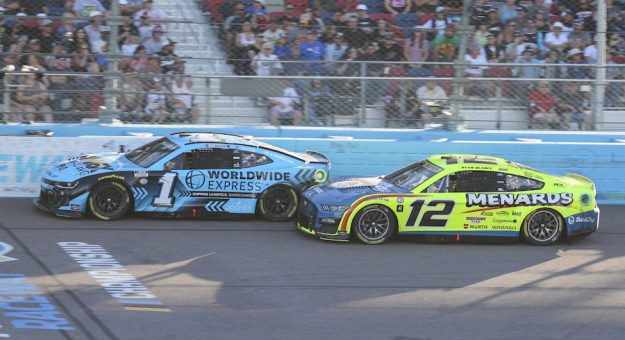INDIANAPOLIS — Nearly 23 years ago, 86 laps into the 2001 Daytona 500, a NASCAR upstart named Kurt Busch rolled out of turn four, in traffic, and eased his car to the right.
He was obviously thinking the car beside him, driven by Dale Earnhardt, would also move to the right, taking the normal line. But Earnhardt had another idea. He was going to slip his black Chevrolet into a gap between Busch to his left and Jeff Burton just ahead, in the outside line.
Earnhardt and Busch met in the middle, their doors smacking together.
Busch’s opinion, which happened to be correct, was that he had done nothing wrong. Earnhardt’s opinion, also correct, was that this pesky kid was standing between himself and his goal for that day, a second Daytona 500 victory.
So Dale Earnhardt did a Dale Earnhardt thing: He stuck his left hand out the window, and displayed for young Kurt Busch the full length of his middle finger. In the television booth was FOX Sports rookie Darrell Waltrip, who in his own driving career had seen every gesture in the Earnhardt playbook.
“Just think how well (Earnhardt) can drive with one hand,” said Waltrip. “If he’d put ’em both on the steering wheel, he’d really be tough.”
It was one of the last legendary moments in a legendary life. Earnhardt died 114 laps later, crashing in the usual mad rush to the checkered flag. Today, there is a statue of him outside Daytona Int’l Speedway. It captures Earnhardt after his 1998 Daytona 500 victory, his left arm upraised, the hand balled into a fist.
I will always see that left arm stretched out, the hand out the window, its middle finger there for the world to see.
Dale Earnhardt shot Kurt Busch the bird at Daytona and Motorsports America loved him for it. He flipped off Jeremy Mayfield at Pocono in 1998, and they loved him for that, too. That was the Earnhardt they craved: raw, blunt, unfiltered.
I’ve been thinking about those Earnhardt episodes in the wake of two events that came 10 days apart in November: Ryan Blaney’s NASCAR Cup Series championship and the death of pioneering broadcaster Ken Squier.
So often when I think of Earnhardt, I hear Squier’s maple-syrup Vermont voice and the imagery he brought to a stock car race. Squier anchored the CBS coverage of the 1979 Daytona 500, Earnhardt’s debut in NASCAR’s keystone event.
When Earnhardt fired his Buick past the Oldsmobile of leader Neil Bonnett on lap 44, Squier sensed that a proper introduction was in order. He used just 49 words, not one more than was necessary.
“Earnhardt!” Squier exclaimed. “Now there’s the kid to watch. This kid Earnhardt in the Osterlund No. 2. The car out of California, the driver from North Carolina. Second-generation driver. His father, one of the most famous short-track drivers in American racing history, the well-known Ralph Earnhardt. His kid looks good today.”
Many years later, far from a microphone, Squier recalled that even in 1979 Earnhardt “had a presence to him that said, ‘Don’t f— with me.’”
Clearly, Earnhardt’s attitude had not changed by 2001, when he and Kurt Busch had their coming together.
Which brings us to this year and Blaney’s title-clinching run at Phoenix Raceway. It was a masterclass in rising to the occasion, punctuated by a couple of red-hot moments: an in-car camera’s timely capture of a middle finger aimed by Blaney at the driver ahead of him, Ross Chastain, and Blaney running into the rear bumper of Chastain’s car as they fought for the lead.
Asked in the post-race press conference if he’d bumped Chastain on purpose, Blaney said, “F—in’ right, I hit him on purpose. … He blocked me on purpose 10 times, so, yeah, I hit him on purpose.”
Few things in sports are more refreshing than honest spontaneity. Yet nothing is more depressingly predictable than the blowback that follows such spontaneity.
The social-media uproar that followed Blaney’s big day was full of cranks bemoaning the “lack of manners” in “this generation’s drivers.” One keyboard jockey, claiming to be a Blaney fan, was miffed that Ryan “didn’t handle the situation like a champion.”
Like which champion? Like Earnhardt?
What do these people want from racing? I’m confused.
If they claimed to be offended by Blaney’s actions purely on the grounds of decency and decorum, and they sounded sincere about that, you’d almost have to concede the point.
But the second they make it about age — the phrase “this generation” is a tipoff — you know instantly what you’re dealing with: Some crabby old relic pining for his yesterdays, without bothering to remember the times in which he actually lived.
You can’t have a problem with Ryan Blaney’s middle finger if you never had a problem with Dale Earnhardt’s middle finger. Period.
Earnhardt and Blaney reached the top in a pursuit that regularly taps into what psychologists call humanity’s six basic emotions: fear, anger, joy, sadness, disgust and surprise. Sure, sometimes in emotional moments they behaved badly. Maybe you’d prefer mannequins in Nomex?
Me? I’ll take a flesh-and-blood racer.
Ken Squier liked flesh-and-blood racers, too. He put everything he had into that 1979 Daytona 500 telecast, pre-taping an interview with Bobby Allison as they flew in Bobby’s airplane and visiting David Pearson’s home for a chat in his trophy room, which Ken likened to a hardware store.
“From the beginning,” Squier told me, “my sense was that racers were interesting people and we needed to know more about them.”
I wish Ken was here to speak for himself, but I’ll bet he found this feisty Ryan Blaney interesting, too. I’ll bet he wanted to know more about him.
Rest in peace, Mr. Squier. Carry on, Mr. Blaney.
This story appeared in the Dec 13, 2023 edition of the SPEED SPORT Insider.

